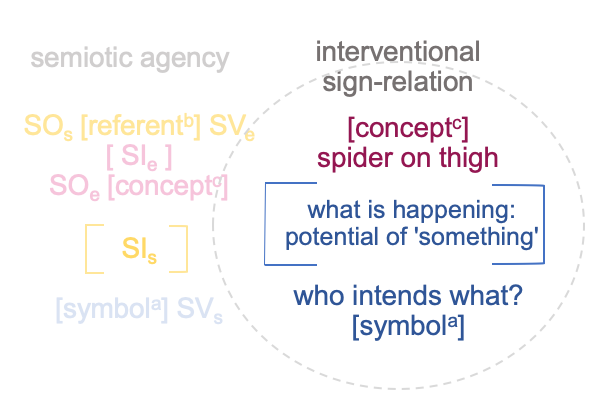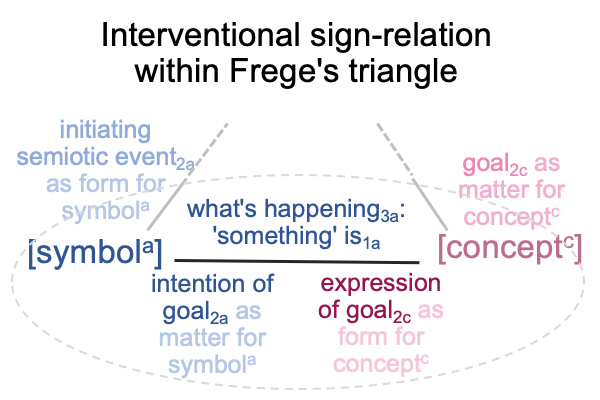1193 Now, this is where a dramatic and a literary choice needs to be made. Do I depict what happens next as another round of semiotic agency or do I say, “Go ahead and act out your interventional sign, because that is the way that nature rolls.”?
Maybe, I can ask Daisy.
1194 Here is a picture of what I am talking about.

1195 What about rhetoric?
The spoken word, “cognition”, would say, “Go another round.”
The spoken words, “innate response”, would say, “Finish the job.”
1196 The biosemiotician has more than one way to depict the interventional sign-relation.
1197 The dyadic actuality of the biosemiotic noumenal overlay is good for empirio-schematic research.
If I ask, “What gives rise to phenomena and what needs to be modeled?”, then the answers are fairly obvious.
The spider on thigh and who intends what? gives rise to phenomena.
[What is happening and the potential of something happening] needs to be modeled.
1198 Frege’s triangle offers another way to engage in biosemiotic inquiry. This triangle portrays reified sign-relations, just like the biosemiotic noumenal overlay, but in a geometric, spiral of triangles. The architecture is like a winding staircase with three steps per whirl.

1199 What if a hominin in the social circle of a team is a semiotic agent?
There is still a conceptc, such as the contiguity between traditional use of iconic and indexal hand-talk words as a manner to convey information (SOe) and the manual-brachial gestures, [image SPIDER][point to THIGH][facial expression of DISTRESS] (SVi).
1200 Surely, the goal2c of the signer is to issue a warning.
The hand-talk statement2c (SVi) stands for a warning2a (SOi) in regards to a normal context that is similar to what is happening3a operating on the potential of ‘something’ happening1a (SIi).
1201 Next there is a contiguity between SOi (as matter) and SVs (as form). Frege’s label, [symbola], corresponds to the [substance] of the dyadic actuality on the content level.
When the signer makes the hand-talk statement, all the members of the team can see it. But, the signer offers an additional clue. The signer is looking at one particular team member. And, this team member has a spider on his thigh.
At the time of the statement, everyone on the team engages in an ongoing activity. Say, shaking ripened fruit from a tree. So, the warning is not exactly in line with the task at hand.
1202 Nevertheless, each member of the team is a symbol (a sign whose object is based on convention) simply because each member is different from any other member of a team. The team is the system of a system of differences or the order of a symbolic order. The team is the convention, so to speak.
So, the comment comes from an elder who is more aware that spiders can appear during this particular collaborative activity. Perhaps, I can say that the elder stands for someone who is aware of the safety of others. But, there is no hand-talk gesture word that images or points to the explicit abstraction of “safety”.
1203 Nevertheless, the protolinguistic hand-talk of hominins living between the start of bipedality and the domestication of fire (3.5-0.8Myr) has hidden symbolic operations working beneath the obvious iconic and indexal manual-brachial word-gestures. The manner in which a spider is pantomimed in [image SPIDER] varies, but only one particular gesture becomes habitual, that is, conventional. The way that the signer has eye contact with the signee when he signs [image SPIDER] then [point to thigh] has all the hallmarks of grammar. It is a symbolic operation. Finally, [facial expression of DISTRESS] may be on its way to being stylized, but at the moment, forget convention!
The goal2c is to warn.
